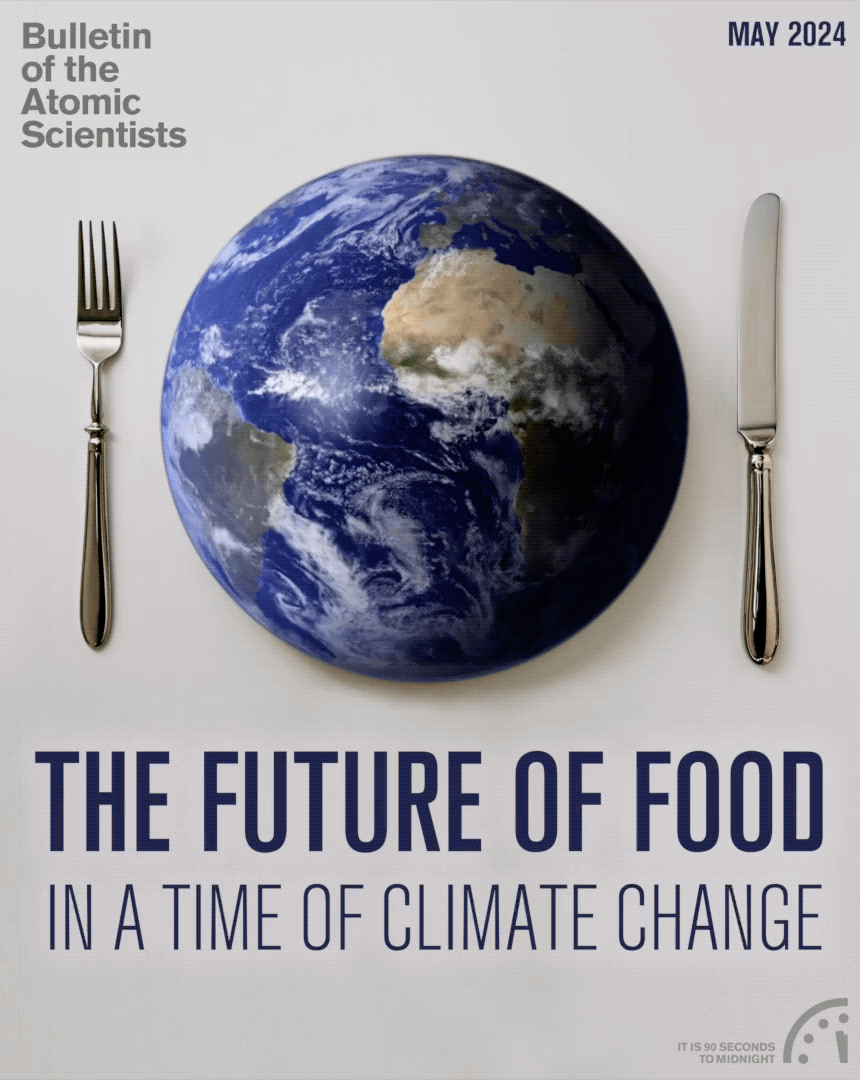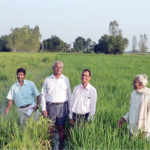We cannot afford another lost year for food and climate action
By Emile Frison | May 7, 2024
We cannot afford another lost year for food and climate action
By Emile Frison | May 7, 2024
When we think of climate change, the images that come to mind are predominantly of polar bears stranded on melting icebergs, plumes of smoke rising from power station chimneys—and maybe forest fires, oil rigs, or solar panels. What we almost certainly don’t think of is the burger sitting juicy on the dinner plate, the cow in the barn, or the ready-made lasagna steaming fresh from the microwave.
It is really only in the last two or three years that food systems have begun to be taken seriously in climate change spaces. Previously, the spotlight had predominantly shone on fossil fuels and our dirty energy systems. This emphasis was rationalized by the undeniable truth that the burning of coal, oil, and gas constitute the primary sources of global warming emissions.
Yet food systems—encompassing the entirety of activities spanning from agricultural production on the farm to processing, distribution, consumption, and disposal—are responsible for fully a third of global greenhouse gas emissions(Crippa et al 2021). At the carbon dioxide equivalent of 18 metric gigatons (gigatonnes), that’s more than the annual emissions of the United States and China combined. Additionally, they contribute significantly to fossil fuel consumption, accounting for 15 percent of total usage (Global Alliance for the Future of Food 2023). Though these food systems emissions may be complicated, dispersed, and inconvenient, they cannot be ignored. According to an influential paper in the peer-reviewed journal Science “even if fossil fuel emissions were eliminated immediately, emissions from the global food system alone would make it impossible to limit warming to 1.5°C [1.5 degrees Celsius, or 2.7 degrees Fahrenheit] and difficult even to realize the 2°C target [3.6 degrees Fahrenheit]” (Clark et al. 2020).
Food on the COP table?
It is to be welcomed, therefore, that after 28 successive summits, annual UN climate negotiations have at last begun to pay attention to food and agriculture. The United Arab Emirates (UAE) presidency of the COP28 climate negotiations promised to put food on the table at the conference in Dubai last December (COP 28 2023a). This shift signals that food can no longer enjoy a free ride, under the radar of scrutiny.
Indeed, the UAE coordinated a “declaration on sustainable agriculture, resilient food systems, and climate action” signed by 159 governments, together representing 70 percent of all food consumed. Signatory governments committed to “whole food system transformation”—not only on-farm emissions, but also those occurring from transportation, processing, packaging, and food waste. They committed to integrating food system actions into their national climate plans by 2025. And to “revisit or orient policies and public support related to agriculture and food systems”—indicating pressure on some of the world’s most generous and damaging public subsidies. A further declaration by a new grouping called the Alliance of Champions for Food Systems Transformation, comprising the governments of Brazil, Cambodia, Norway, Rwanda, and Sierra Leone, made the strongest promises yet, including that they would report annually on targets to reduce food system emissions (Alliance of Champions for Food Systems Transformation 2023). For its part the UN’s Food and Agriculture Organization (FAO) published the outline of a “roadmap for achieving SDG2 (zero hunger by 2030) without breaching the 1.5C threshold.” COP28 also paid host to hundreds of side-events discussing food systems. Perhaps confirming the increased interest, food and agriculture firms sent three times as many lobbyists to the summit as the previous year (Sherrington, R, Carlile, C., and Healy, H. 2023).
Missing in action
Yet, what did this flurry of voluntary initiatives, declarations, promises, funding announcements, and panel discussions really add up to? Still no plan exists to tackle the “missing third” of the greenhouse gas pie from global food chains. The declarations did not translate into any binding agreements or targets set; nor is there even a plan to make a plan.
The final Global Stocktake text that emerged at the conclusion of COP28 negotiations did not mention action to tackle agricultural emissions or food system transformation—though it did for the first time “recognize the fundamental priority of safeguarding food security and ending hunger, and the particular vulnerabilities of food production systems” in relation to adapting to climate change (UNFCCC 2023). This marked an important, if insufficient, acknowledgement of the major impacts that extreme weather and hotter temperatures are beginning to exert on farmers and food security.
This stocktake text was the culmination of a process of analyzing every nation’s plans (technically known as “nationally determined contributions”) to meet the Paris Agreement—which collectively showed that current efforts inevitably lead to a temperature rise of up to 1.4 degrees Celsius above the 1.5 degrees Celsius threshold, far short of the Paris goals (UNEP 2023.). Governments’ pledged actions on food systems were markedly weak and fragmented (IPES-Food 2023). The plans that do exist lack joined-up approaches that span the whole food system; lack coordination between local, regional, and national levels of government; and lack measurable commitments. For example, governments have shown a remarkable reluctance to join up supply-side and demand-side practices in order to drive more sustainable diets and food systems. Only two countries included measures to shift to sustainable food production and consumption and to reduce loss and waste: Liberia and Malawi.
The negotiated Global Stocktake agreement is akin to a teacher’s warning to “go back and redo your homework.” The glaring omission of the carbon emitted by food systems from the list of points to improve is therefore a dangerous oversight and a stark betrayal of urgency. It leaves a gaping black hole, just as the global heating target of 1.5 degrees Celsius hangs in jeopardy.
What needs to happen?
Food systems can be admittedly complex for policy makers to shift. Agri-food lobbies, every bit as powerful as fossil fuels lobbies, exert enormous influence over politicians. Food systems can impinge upon numerous interlocked policy priorities—not only climate but health, food security, environment, labor, livelihoods, economy, and trade. Furthermore, food systems get personal, touching on sensitive issues of culture and identity and are rapidly becoming embroiled in culture wars (Cunningham 2022), creating a febrile environment for rational policy making (Vinocur and Brzezinki 2024).
Nevertheless, perhaps more than for other polluting industries, sustainable solutions are readily available for food systems. These could generate not only major reductions in greenhouse gas emissions in a short time, but also provide a wide range of social, health, economic, and environmental benefits. Halving food loss and waste across the entire supply chain could mitigate up to 8 percent of annual global greenhouse gas (GHG) emissions (Zhu et al. 2023). Well-managed changes to agricultural production practices could mitigate about 18 percent of GHG emissions, while building soil fertility, protecting ecosystems, and strengthening resilience to climate shocks (Roe et al. 2019). Studies have shown that transitioning to sustainable, healthy diets and halving global industrial meat production and consumption could mitigate a further 8 percent, while improving health and reducing pressures on land and ecosystems (WWF 2020).
Although national governments are falling short, many cities and regional governments are succeeding in pioneering policies on food and climate change while providing broader social and environmental advantages—showing that it is possible. Their climate pledges go 35 percent above and beyond the emissions cuts committed by national governments—and provide a blueprint for effective action on food and climate, in which social justice, participation, and accountability are put at the heart of climate action. From mega-cities to small towns, local governments are fostering close connections with their citizens and putting health and social justice at the heart of their food and climate policies, while protecting vulnerable communities.
For example, the mega-city of São Paulo, Brazil, protects forests and farms in nearby rural districts from urban development, trains family farmers in sustainable practices, and finds urban buyers for their fresh organic produce: The program is protecting the Atlantic Forest, the most threatened biome in Brazil. A number of cities have been steadily steering their citizens toward more sustainable and healthy diets, including places like Copenhagen and New York City—whose program of providing plant-based meals as a default in its public hospitals racked up a 36 percent reduction in carbon emissions associated with food in the first year (soon to be followed by the city’s schools, senior centers, homeless shelters, and even jails).
Approaching food and farming policy in a holistic, cross-cutting way could prove key to unlocking action and funding on the missing third. Food systems are not just carbon machines and should not be measured by carbon metrics alone. Beyond climate, food systems also require deep transformation for reasons of hunger and ill health, biodiversity and pollution crises, deteriorating livelihoods, inflation, and labor abuse. We know it is the industrialized food system—characterized by monocultures, industrial livestock, high use of fertilizers and chemicals, processing, long food chains, and food waste—that is largely responsible for food systems emissions. We must therefore redesign our food and farming systems, based on ecological principles, to significantly reduce GHG emissions and sequester carbon in healthy ecosystems (Altieri and Nicholls 2017).
Agroecology—an ecologically, socially and economically sustainable approach to food and farming—demonstrates numerous agronomic, social, and economic benefits that will prove paramount to our ability to mitigate emissions while adapting to a rapidly changing climate (IPES-Food 2022a). It has comparatively minimal greenhouse gas emissions and can sequester significant amounts of carbon (Aubert, Schwoob, and Poux 2019). And by promoting diversity, resilience, social values, cultural practices, and low resource use, it can increase the resilience of farms, landscapes, and food chains.
Transformation
To be clear, gradualist approaches aimed at merely making minor adjustments to the industrial food system will not be enough to close the loophole of the missing third of greenhouse gasses by 2030, nor to get us off the high-pollution, high-fossil-fuel, high-hunger track we’re on. Well-meaning but incrementalist initiatives within the current industrial food paradigm are emerging just as rapidly as the increasing prominence of food systems in climate negotiations. Tweaking cows’ diets, tinkering with plant breeding, cellular meat, digital farming—these are all garnering attention and money at the expense of the major changes needed. (These are often accompanied by a whole world of appealing but misleading jargon, such as “climate smart,” “nature-based,” and “precision agriculture.”) (IPES-Food, 2022b).
The FAO’s 1.5C Roadmap, in its ambition to align food systems with the 1.5 degrees Celsius threshold while eradicating chronic hunger by 2030, exemplifies just such an approach—one that primarily focuses on marginal enhancements and minor agricultural efficiency gains, rather than challenging the fundamentals of the current inequitable system (FAO 2023). Lacking a clear signal to restructure food systems around diversity, circularity, and agroecology, the FAO’s prescriptions are unlikely to sufficiently shift the trajectory on the missing third of greenhouse gas emissions. Nor are its prescriptions likely to turn the dial on the power dynamics of the BigAg corporations who are squeezing farmers out of a living and funneling crops into livestock feed, biofuels, and ultra-processed foods instead of feeding those in hunger.
While it may have taken 28 years for food systems to secure their place on the COP agenda, we now have only a fraction of that time to move to action to transform food systems and begin closing the greenhouse gas loophole. With the goal of restricting global warming to 1.5 degrees hanging in precarious balance, ignoring climate action on food systems is no longer an option.
Acknowledgments
The author would like to thank the Agroecology Coalition and the Global Alliance for the Future of Food.
Funding
This paper received no specific grant from any funding agency in the public, commercial, or not-for-profit sectors. More information on IPES-Food’s core funding can be found at https://ipes-food.org/about/.
Together, we make the world safer.
The Bulletin elevates expert voices above the noise. But as an independent nonprofit organization, our operations depend on the support of readers like you. Help us continue to deliver quality journalism that holds leaders accountable. Your support of our work at any level is important. In return, we promise our coverage will be understandable, influential, vigilant, solution-oriented, and fair-minded. Together we can make a difference.
Keywords: 2024 election, agriculture, agroecology, biodiversity, climate action, farming, food
Topics: Climate Change, Special Topics





















